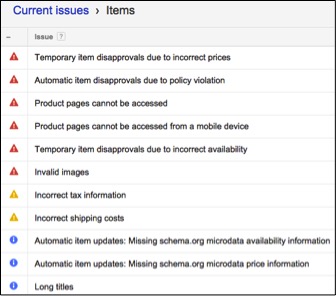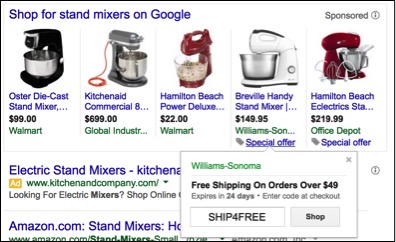At this point, any ecommerce advertisers who aren’t running Google Shopping campaigns (or have at least tried them) are being left in the dust. According to RKG’s Q4 2014 Digital Marketing Report, Shopping ads drove 51% more clicks and 45% greater ad spend year over year. Take Shopping management a step further and you have the upload and optimization of the product feed. For advertisers with 1000s of products, deciding not to have a dedicated feed resource will result in lost revenue from a channel that has consistently proven to garner high performance.
Most often this resource comes in the form of a feed provider. These providers offer an end-to-end solution from feed creation to day-to-day inventory management. Some providers also offer their own AdWords, Bing and Comparison Shopping Engine (CSE) management. In the absence of a feed provider, someone from the IT or development team generally creates and uploads the feed. Whoever it may be, the feed needs the attention it deserves not only for Shopping campaigns, but also for the growth and prosperity of PPC accounts.
Shopping’s Role In The Conversion Process
What better justification for proper feed management than looking at how performance is impacted? Shopping campaigns tend to garner many last click conversions, but they also help in the overall process. In looking at the Search Funnels report, we can see all conversion paths that had at least two touch points. For example, a user may have typed in a generic query and clicked our ad. Two days later that user remembered the brand name, typed in the query, and clicked the brand ad to convert. The generic query would get the assist while the brand term would be attributed the last click conversion.
I took a look at three of our accounts during the time period of 12/1/14 – 2/8/15 to see how many conversions Shopping was a part of. This study only looks at conversion paths with at least two touch points. It did not matter if the Shopping campaign was the first or last click or anywhere in between. The data is as follows.

With the clients who saw a greater volume of overall conversions (A and C), a Shopping campaign click was part of the path roughly one out of every five times. For client B, a Shopping campaign click was part of the conversion path half the time. Along with single click conversions, Shopping campaigns play a role in the PPC conversion funnel.
Google Merchant Center
The feed resource needs to understand the Google Merchant Center interface. This platform contains essential information such as feed errors and shipping information. As an example, here’s a list of feed issues that could arise.

The resource should be able to identify these issues and know how to solve them. In the image above, the first issue is “Temporary item disapprovals due to incorrect prices,” meaning the price in the feed does not match the price on the site. This error is a major issue and could lead to feed suspension if unchecked. Other errors generally relate back to inaccuracies between the feed and site as well as policy violations.
Shipping
Another area that Google has become much stricter about is shipping. Google requires that shipping be calculated with one of the methods below.
Single Rate – a flat cost or percentage of product price that is valid everywhere in the targeted country
Rate Table – multiple rates according to one or two dimensions such as product rate and price
Carrier-Calculated Rate – specified rates according to carrier (UPS, USPS and FedEx)
Rules – Calculated rate based upon multiple dimensions
When these shipping methods don’t match from feed to site, Google will send a suspension warning notice. Unless fixed within the designated time period, Google Shopping ads will cease showing.
Affiliates
An often-overlooked setting is affiliate advertising. Hidden with the “Settings” section is the option for affiliates to advertise products from the merchant’s site.

If given approval, merchant products can show in affiliates’ Shopping ads. For example, a search for blue widgets may showcase an ad from the advertiser or an ad from the affiliate (such as Shopzilla). Affiliate advertising can equate to more exposure for merchants, but it can also lead to fewer clicks for that particular advertiser. In other words, an advertiser’s own Shopping campaign efforts have the potential to be negated due to affiliates.
Merchant Promotions
A relatively new feature within Merchant Center, the promotions feature was first introduced in 2013. Merchants could submit a promotions feed that encompassed special offers (similar to the since retired offer extensions). The Shopping ads would then contain a “Special offer” link that when clicked, would show the deal and countdown to when it ended. Here’s an example of what this format looks like.

What’s changed is how promotions are setup. Merchants no longer need to submit a separate promotion feed. Promotions can be setup directly in the interface and entail the:
- Special offer
- Promo code (if applicable)
- Dates for which the promotion will run
- Country and language of promotion
Normal promotional text in Shopping campaigns only shows when a user hovers over an ad or there are only two units present. Merchant promotions are a great way to add extra emphasis to your ads.
Feed Optimization
Along with tracking Merchant Center notifications, the feed should be updated similarly to how pages are optimized for SEO. Just like page titles and meta descriptions, product titles and summaries can be written with keywords in mind. Dave Schwartz at DataPop wrote an interesting article about how to SEO Your Product Feed.
It’s also worth taking your own product photo shoots. Generally, merchants just use the manufacturer product images. When competing against other merchants, these images may look repetitive. By using your own images, your ads can stand out against the others.
Conclusion
Maintaining the product feed and its associated parameters and uses may have once been a minimal task, but it does now require a dedicated resource. The implications of ignoring the feed will be seen in Shopping campaigns when performance suffers. At the very least, the person responsible for uploading the feed should follow the Google Commerce blog for the latest news and updates.
On a final note, Google recently introduced a Shopping certification to go along with its other AdWords certifications. I wouldn’t be surprised if in the near future we see a certification around the product feed or Google Merchant Center itself.



